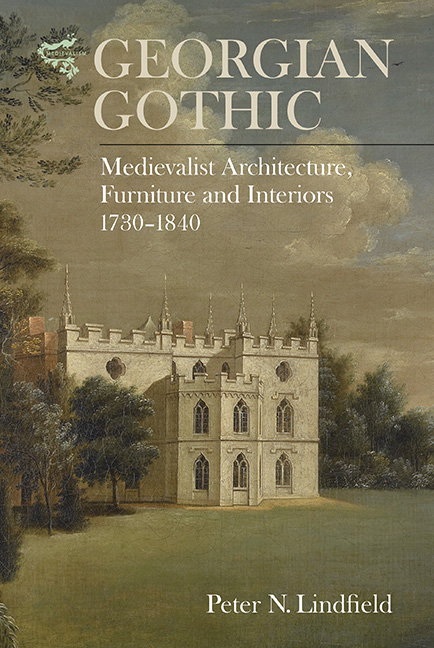Book contents
- Frontmatter
- Dedication
- Miscellaneous Frontmatter
- Contents
- List of Illustrations
- Acknowledgements
- Introduction: the Gothic Aesthetic in Britain and British Furniture, 1730–1840
- 1. Understanding Gothic Architecture in Georgian Britain
- 2. Creation of Classical Gothic Architecture, Furniture and Interiors
- 3. High Fashion and Fragments of the Past: the Omnipresence of Rococo Gothic
- 4. Fluctuating Tastes: Gothic in Later Eighteenth-century Britain
- 5. The ‘Chaos of Modern Gothic Excrescences’: Regency to Revolution
- Conclusion
- Appendix
- Bibliography
- Glossary
- Index
- Miscellaneous Endmatter
3. - High Fashion and Fragments of the Past: the Omnipresence of Rococo Gothic
Published online by Cambridge University Press: 25 October 2017
- Frontmatter
- Dedication
- Miscellaneous Frontmatter
- Contents
- List of Illustrations
- Acknowledgements
- Introduction: the Gothic Aesthetic in Britain and British Furniture, 1730–1840
- 1. Understanding Gothic Architecture in Georgian Britain
- 2. Creation of Classical Gothic Architecture, Furniture and Interiors
- 3. High Fashion and Fragments of the Past: the Omnipresence of Rococo Gothic
- 4. Fluctuating Tastes: Gothic in Later Eighteenth-century Britain
- 5. The ‘Chaos of Modern Gothic Excrescences’: Regency to Revolution
- Conclusion
- Appendix
- Bibliography
- Glossary
- Index
- Miscellaneous Endmatter
Summary
I wish I could find out how many of the queer suggestions in these books were put into practice. Gothic window-frames, the most insignificant, have also been the most enduring examples of the craze, and are to be met with in many old towns.
(Kenneth Clark, 1962)KENNETH CLARK INTRODUCED the term ‘Rococo Gothic’ in his seminal monograph, The Gothic Revival: An Essay in the History of Taste (1928). The label owes its existence to Clark's conclusion that Gothic was revived in the eighteenth century either for imaginative purposes, or because designers wished to use it as an exuberant decorative form. The romantic revival of Gothic forms, as he phrased it, produced a distinctive type of Gothic design that was inspired by the ruins of medieval architecture, and it was displayed ‘in other and more frivolous ways, producing a quantity of work which is not easy to classify. I have called it Rococo […] because it conveys a purely decorative style – something self-conscious, a little far-fetched, and not too serious.’ Rococo Gothic thus describes two quite separate manifestations of medieval-inspired design considered in this chapter, namely a whimsical application of Gothic motifs to architectural elevations, and the introduction of Gothic motifs into mid eighteenth-century applied design: the Rococo. Both types share an air of whimsicality, yet only one, the latter, is based directly upon the form and motifs of the Rococo.
Clark posits that there is ‘good reason for believing that Rococo Gothic, if viewed historically rather than for its own sake, has a considerable place in the revival’. His opinion is infrequently shared, and Rococo Gothic has been typically derided as an aberration and dealt with in a somewhat cursory manner: its form, function, stylistic development and relationship to medieval architecture are explored sparingly. This is manifest in the variety of names that have been applied to the style: Gothick, Rococo-Gothic, or, even, Rococo-Gothick. The ‘k’ became a sign of ridicule and contempt in the nineteenth century and, thereafter, it came to denote a style characterised by frivolity, superficiality of detail and in contravention of architectural norms. Michael McCarthy, in his landmark monograph, The Origins of the Gothic Revival (1987), goes further and rejects the Rococo Gothic outright, considering it as ‘a nonsense category’ that is far removed from his own interests in antiquarian Gothic forms.
- Type
- Chapter
- Information
- Georgian GothicMedievalist Architecture, Furniture and Interiors, 1730-1840, pp. 81 - 130Publisher: Boydell & BrewerPrint publication year: 2016

